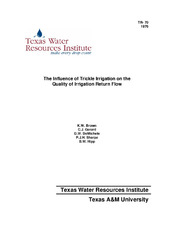| dc.creator | Brown, K. W. | |
| dc.creator | Gerard, C. J. | |
| dc.creator | DeMichele, D. W. | |
| dc.creator | Sharpe, P. J. H. | |
| dc.creator | Hipp, B. W. | |
| dc.date.accessioned | 2011-07-01T19:31:45Z | |
| dc.date.available | 2011-07-01T19:31:45Z | |
| dc.date.issued | 1976-03 | |
| dc.identifier.uri | https://hdl.handle.net/1969.1/94913 | |
| dc.description.abstract | The influence of trickle irrigation on the quality of irrigation return flow was investigated in a field study and by means of computer simulation models. Six undisturbed buried monolith lysimeters were utilized to quantify the leachate from treatment including two different qualities of irrigation water applied through a trickle irrigation system. Both moisture and salt balances were followed inside and outside the lysimeters during a growing season the remainder of the calendar year. A sorghum crop was grown on the lysimeters and in the adjacent area. Irrigation was scheduled based on pan evaporation losses. The irrigation water of high salt content was obtained from a deep well while the irrigation water of low salt content was drawn from the district irrigation canal. The water balance monitored by the neutron probe showed that differences between inside and outside lysimeters were small. The soil contained significant amounts of salt at the begining of the experiment and trends in the leachate concentration resulting from irrigation treatment are difficult to see after one year of monitoring. Differences between paired lysimeters are large indicating large variability in soil characteristics across the field.
Differences in water use inside and outside the lysimeters indicated that during the 1974 growing season, which was dryer than normal, the sorghum crop may have extracted approximately 8% of the water required from the water table.
Yield and growth data indicated that the plant root environment inside and outside lysimeters were relatively comparable. Nitrogen, saline water and irrigation treatments did not significantly influ- ence growth and yields of sorghum in 1974.
During the test period, N03-N loss in effluents ranged from a low of 14 kg/ha from a lysimeter treated with 112kg/ha to a high of a- bout 75 kg/ha from a lysimeter treated with 224 kg/ha of N. Nitrate losses were negligible compared to checks when N application rates to sorghum were 112 kg/ha. Most of the N03-N losses occurred during non-cropped periods when lysimeter drainage volumes were at a maximum. Total salt in drainage waters ranged from about 2600 to 4200 kg/ha during the test period. Inherent soil variability was an important factor in salt and nitrate loss in drainage waters from the lysimeters. | en |
| dc.language.iso | en_US | |
| dc.publisher | Texas Water Resources Institute | |
| dc.relation.ispartofseries | TR;70 | |
| dc.title | The Influence of Trickle Irrigation on the Quality of Irrigation Return Flow | en |
| dc.type | Technical Report | en |


